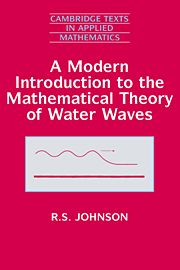Book contents
- Frontmatter
- Contents
- Preface
- 1 Mathematical preliminaries
- 2 Some classical problems in water-wave theory
- 3 Weakly nonlinear dispersive waves
- 4 Slow modulation of dispersive waves
- 5 Epilogue
- Appendices
- A The equations for a viscous fluid
- B The boundary conditions for a viscous fluid
- C Historical notes
- D Answers and hints
- Bibliography
- Subject index
B - The boundary conditions for a viscous fluid
Published online by Cambridge University Press: 04 May 2010
- Frontmatter
- Contents
- Preface
- 1 Mathematical preliminaries
- 2 Some classical problems in water-wave theory
- 3 Weakly nonlinear dispersive waves
- 4 Slow modulation of dispersive waves
- 5 Epilogue
- Appendices
- A The equations for a viscous fluid
- B The boundary conditions for a viscous fluid
- C Historical notes
- D Answers and hints
- Bibliography
- Subject index
Summary
The inclusion of viscosity in the modelling of the fluid requires that, at the free surface, the stresses there must be known (given) and, at the bottom, that there is no slip between the fluid and the bottom boundary. The surface stresses are resolved to produce the normal stress and any two (independent) tangential stresses. The normal stress is prescribed, predominantly, by the ambient pressure above the surface, but it may also contain a contribution from the surface tension (see Section 1.2.2). The tangential stresses describe the shearing action of the air at the surface, and therefore may be significant in the analysis of the motion of the surface which interacts with a surface wind. The bottom condition is the far simpler (and familiar) one which states that, for a viscous fluid, the fluid in contact with a solid boundary must move with that boundary.
The appropriate stress conditions are derived by considering the equilibrium of an element of the surface under the action of the forces generated by the stresses. The normal and shear stresses in the fluid (see Appendix A) produce forces that are resolved normal and tangential to the free surface, although the details of this calculation will not be reproduced here. It is sufficient for our purposes (and for general reference) to quote the results – in both rectangular Cartesian and cylindrical coordinates – for the three surface stresses.
- Type
- Chapter
- Information
- A Modern Introduction to the Mathematical Theory of Water Waves , pp. 397 - 398Publisher: Cambridge University PressPrint publication year: 1997



